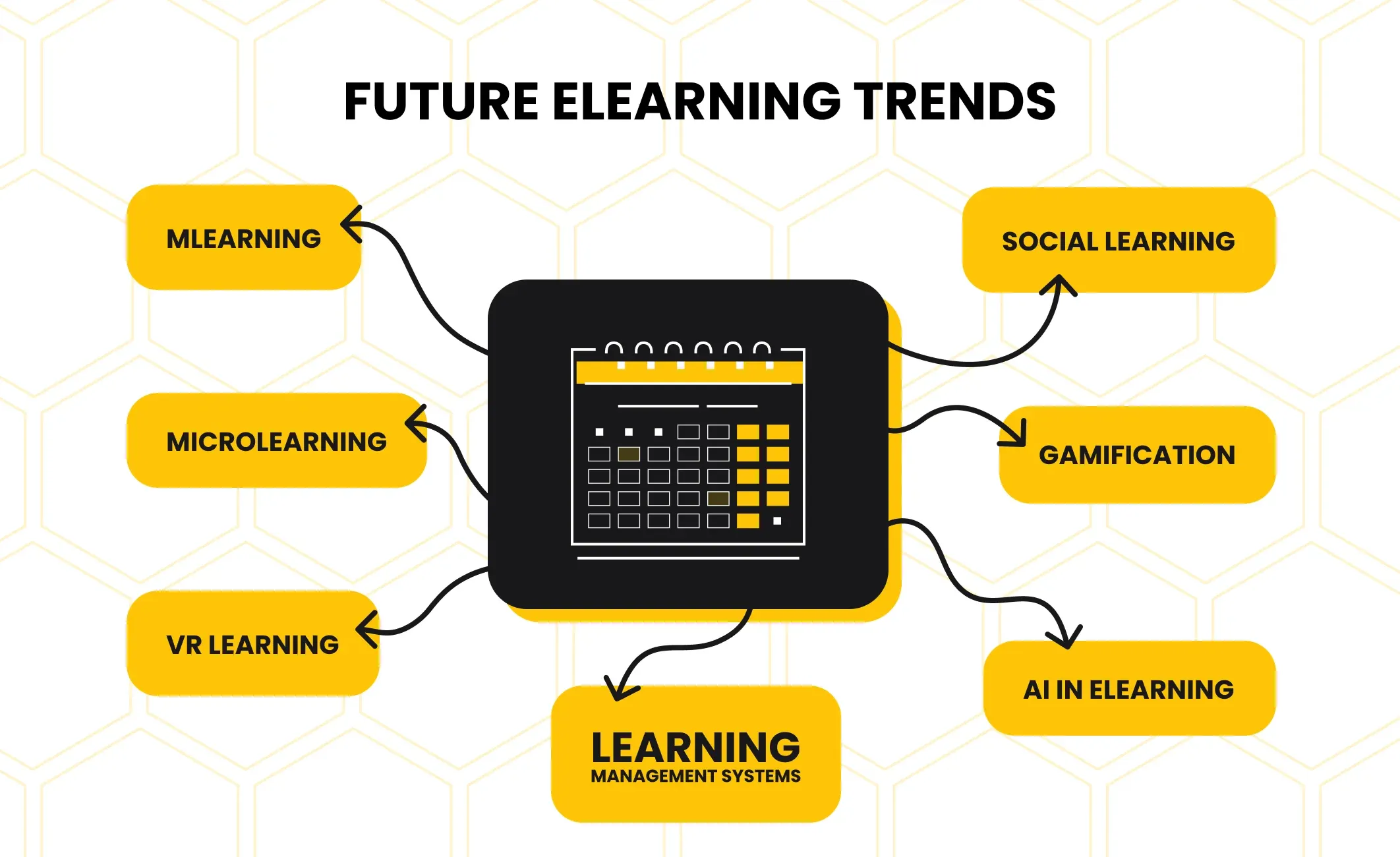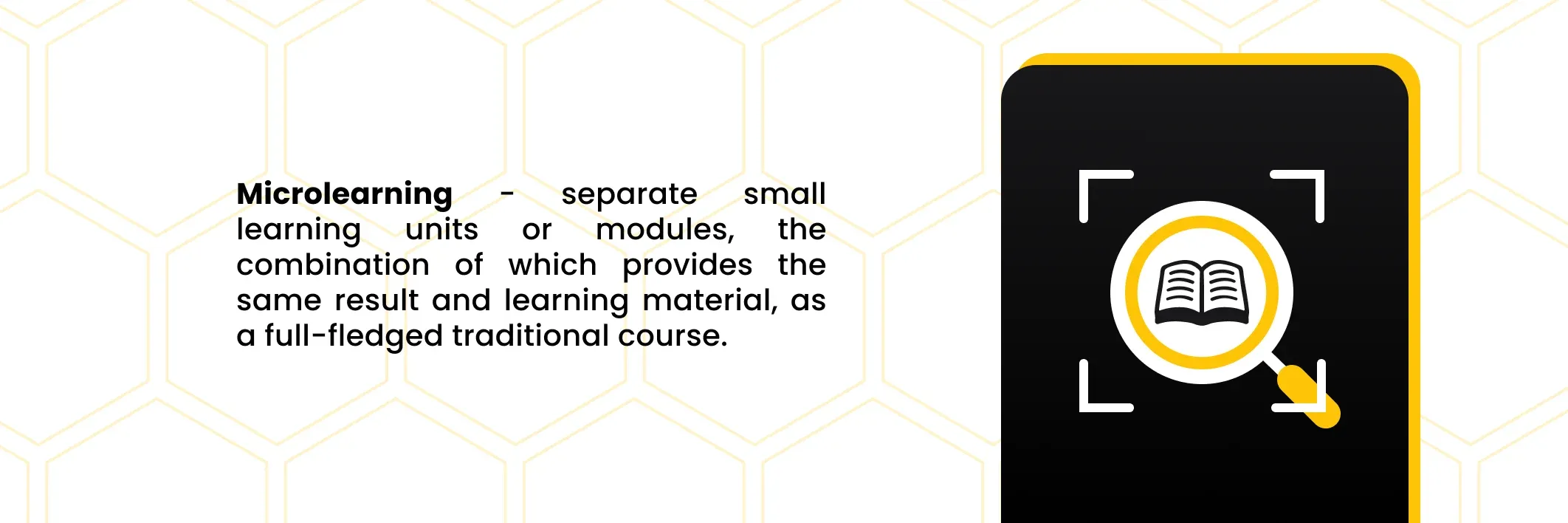EdTech
How are eLearning Trends Going to Leverage Education?
February 04, 2022 • 411 Views • 14 min read
Bohdan Vasylkiv
CEO & Co-Founder
The eLearning industry tends to grow with technological innovations, like any other industry on the market. Since 2000 Online Education sector increased by 900%, and the forecast for the future is quite positive. Everyone might find it difficult to keep up with the recent eLearning trends. Nevertheless, as a brief refresher, eLearning is shifting to more engaging ways.
Today’s digital learning process innovations are likewise evolving into more interactive forms, with a heavy emphasis on AR/VR and gamification to capture and retain learners’ attention. But how did blackboards and projectors in classrooms transform into digital learning innovations, growing day by day?
Let’s explore the development progress of the whole e-learning industry, which led to the trends we have now and will have in the future.
The Development Of the eLearning Industry
The first efforts to create electronic devices specialized for education resulted in the ‘testing machine’ in 1924. This technology allowed pupils to put their knowledge to the test. Then, in 30 years, a Harvard Professor, B. F. Skinner, devised the ‘teaching machine’ that allowed schools to provide pupils with programmed tutoring. Then in the 60s, it evolved into PLATO – Programmed Logic for Automated Teaching Operations.

As the 1970s progressed, the variety of online learning platforms became increasingly interactive. The Open University in the United Kingdom was eager to take benefit of e-Learning app. Their educational system has traditionally been heavily based on remote learning. With the growth of the internet, the Open University was able to provide a broader selection of collaborative learning programs, as well as greater interaction with students via email and other means.
And now eLearning is not going away. Looking at these patterns, it’s apparent that the sector is still progressing and evolving. Students from all over the world are now actively involved in the eLearning process.
Furthermore, well-known firms utilize eLearning programs and technologies to teach and track their employees’ development. The fast expansion of digital connection, information, and technology has provided eLearning with the impetus it requires to advance.
Future eLearning Trends
Instead of emerging as a specialized notion in the education market, eLearning is quickly becoming the primary approach to imparting knowledge to people of all backgrounds. Yet, as it is still extremely dynamic, the notion is always growing and changing.

Towards that intention, we’ve highlighted patterns that we feel point to the future of eLearning and its place in teaching.
Social Learning
Social learning styles apply the fundamentals of interpersonal interactions and teamwork to the present technological age. Discussion platforms, chat groups, file-sharing platforms – teammates may offer some insight and assistance in a variety of ways from everywhere.
There are several uses for social learning in digital realities. E-learning platforms that employ these services include video lessons, live chatting, forums, and discussion boards where users may share their knowledge and expertise. Assessments and comments during lessons are distributed to all learners.
Moodle is a common eLearning software that includes social learning advanced features. It provides a seminar as well as a peer grading practice. Learners share tasks, which are subsequently disseminated to their classmates for assessment based on a specifically established grading system. Moodle also has chatroom functionality, forums, media incorporation, and private messaging options.
Mobile Apps for Learning (mLearning)
Everyone likes the opportunity to accomplish things while on the go in today’s fast-paced professional environment. Although not exactly a component of ‘conventional’ eLearning, the emergence of mLearning applications is an important trend to explore.
Phone-based language-learning mobile applications rising to the fore are the main example of mLearning. While this is a positive beginning, mLearning architectures must still find methods to adopt the same learning aspects that the eLearning industry has, in order to become mainstream and commonplace. Having said that, there is no doubt that mLearning will become a massive trend in the future.
Virtual Learning
360-degree images, graphical overlays, and an immersive interface are just a few examples of virtual learning and augmented reality uses in eLearning. For education, VR enables students and teachers to comprehend complex concepts using immersive personalized learning experiences. Dive into the brain cells, fly to the earth’s orbit, or explore significant locations worldwide, for example.
In fact, augmented and virtual environments learning enables practitioners to thoroughly involve their learners in the subject matter, whether it be mathematics, physics, history, or literature. Furthermore, virtual training and learning assist in elevating the other aspects of online education to new heights.
When combined with virtual reality learning, video learning, gamification, and mobile learning have never been more immersive, and the technology is always developing.
Learning Management Systems
Employers and managers routinely use eLearning management systems and course management systems, or CMS, like Moodle to produce and store digital information in many collaborative organizations and workplaces. This idea has recently spread into the field of eLearning. With the introduction of learning management systems, instructors and other eLearning practitioners may design, record, and administer the online courses and curriculums that are created.
Given the behind-the-scenes nature of learning management systems, it is now easier than ever to plan and course-correct. In either instance, the capacity of a learning management system used to exchange information and incorporate assets at the last minute allows for this type of content curation activity.
As new means of learning, particularly eLearning, become increasingly digitized and supported, the availability of a learning management system will make course preparation and management a snap, effectively replacing the old analog techniques. As a result, learning management systems are here to stay.
Gamification in the Education Industry
Game-based learning is always more engaging, not to mention more digestible, when it’s entertaining, whether you’re five or fifty. This aspect of eLearning is known as gamification, and it aims to make teaching enjoyable!
We don’t only mean quizzes and polls when we talk about gamification. From quick-fire question rounds to gamified scenario-based simulations, it may be as simple or as sophisticated as you wish.
Ultimately, the goal is to capture your learners’ attention and inspire them to participate. This all could be achieved by building an app with multiple ways for tutors to interact with learners. Different APIs or the development of internal activities in software might help with that.
Given the wide range of beneficial outcomes, there’s no reason why gamification in education won’t be used in classrooms, both digital and physical, for the foreseeable future. Furthermore, given the rather impersonal character of eLearning in particular, industrial gamification in education is not only encouraged but also ideal.
Microlearning

It’s understandable that many students, regardless of age, may feel intimidated by the thought of massive, multi-phase projects. Those children, as well as collaborative classrooms throughout the world, that have discovered the benefits of breaking up projects, classes, and other learning materials into digestible portions, namely the microlearning concept, have resulted in considerably higher success.
These parts of microlearning apps might take the form of video lectures, readable text, or interactive exercises, to mention a few examples.
A microlearning program is also significantly less expensive to create. It requires fewer resources and teaching staff. You wouldn’t need additional tools to generate your material; a standard LMS would suffice.
Microlearning is a kind of a concept that has spread further than eLearning and into formal education systems. As a result, the widespread adoption of microlearning is not yet complete.
AI in Education
Artificial Intelligence helps the eLearning sector by bringing a variety of benefits. It enhances learners’ experiences and motivates them to achieve better. AI in education also optimizes and enhances the efficiency of everyday activities. It generates personalized study programs for students based on their learning pace and success.
By integrating AI into education, machine e-learning applications and platforms are assisting in providing support services to students.
Some tools, for example, assist students in automatically scheduling their course load and propose courses, majors, and career options. The proposals and offerings from a system, are all based on how students with comparable data profiles fared in the past.
Duolingo is an excellent example of AI in education. This language learning program provides a placement exam that is unique to each user. It employs artificial intelligence to tailor the questions depending on your prior replies. Duolingo also uses artificial intelligence to tailor sessions. It even created an AI chatbot to assist trainees with conversation practice.
Wrapping Up
It’s amazing to see how far eLearning has progressed, from mLearning to immersive learning. The trends discussed above are only a few of the major ones that will affect the business and set the way for future improvements.
eLearning software development is changing the way we think about knowledge transmission, and we can’t wait to see how far it can go.
As the eLearning market expands, it is important to pay close attention to these new changes – rethink your training programs and reassess your strategy to suit the changing demands of your learners, especially during times of uncertainty.
If you are ready to implement some of these new EdTech trends or develop them from scratch – drop us a line and we will create a customized solution together!
What’s your impression after reading this?
Love it!
2
Valuable
1
Exciting
1
Unsatisfied
1
FAQ
Let us address your doubts and clarify key points from the article for better understanding.
Why should I pay attention to eLearning trends in education?
Dynamic Learning Environments: eLearning trends are reshaping educational landscapes, providing dynamic and interactive learning environments that cater to diverse learning styles.
What role do emerging technologies play in eLearning trends?
Incorporation of AI and VR: eLearning trends are leveraging artificial intelligence (AI) and virtual reality (VR) to enhance engagement, personalization, and the overall learning experience.
How do eLearning trends impact accessibility and inclusivity in education?
Accessible Learning Resources: Trends in eLearning are promoting the development of accessible and inclusive learning resources, ensuring that education is available to a wider and more diverse audience.
Can eLearning trends address personalized learning needs?
Adaptive Learning Systems: Emerging trends in eLearning include adaptive learning systems that tailor content delivery based on individual student needs, promoting a more personalized and effective learning experience.
Are eLearning trends only focused on formal education?
Lifelong Learning: eLearning trends extend beyond formal education, emphasizing the importance of continuous, lifelong learning by providing easily accessible and relevant courses for personal and professional development.
How do eLearning trends impact the role of educators?
Facilitators of Learning: Educators become facilitators of learning, guiding students through interactive and collaborative eLearning platforms rather than traditional lecture-based methods.
you may also like
Let’s talk!
This site uses cookies to improve your user experience. Read our Privacy Policy
Accept

Share this article